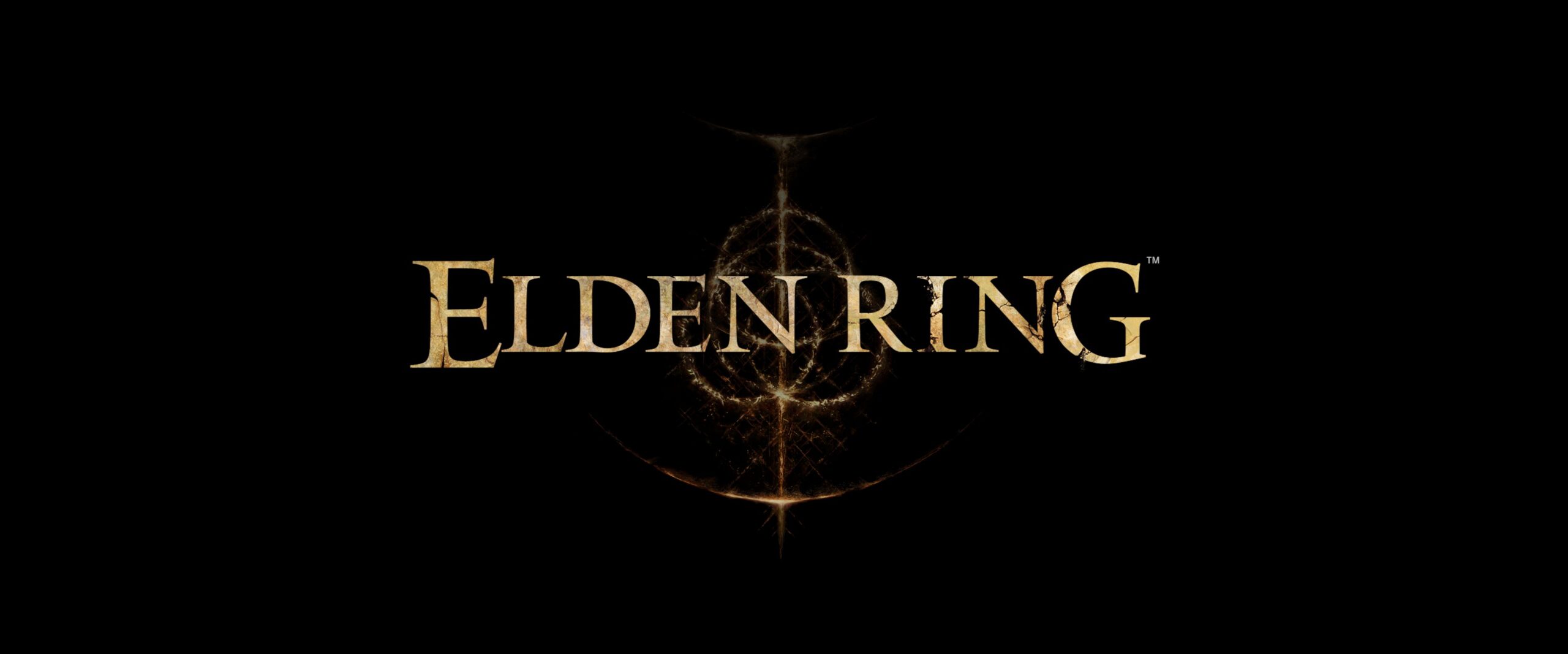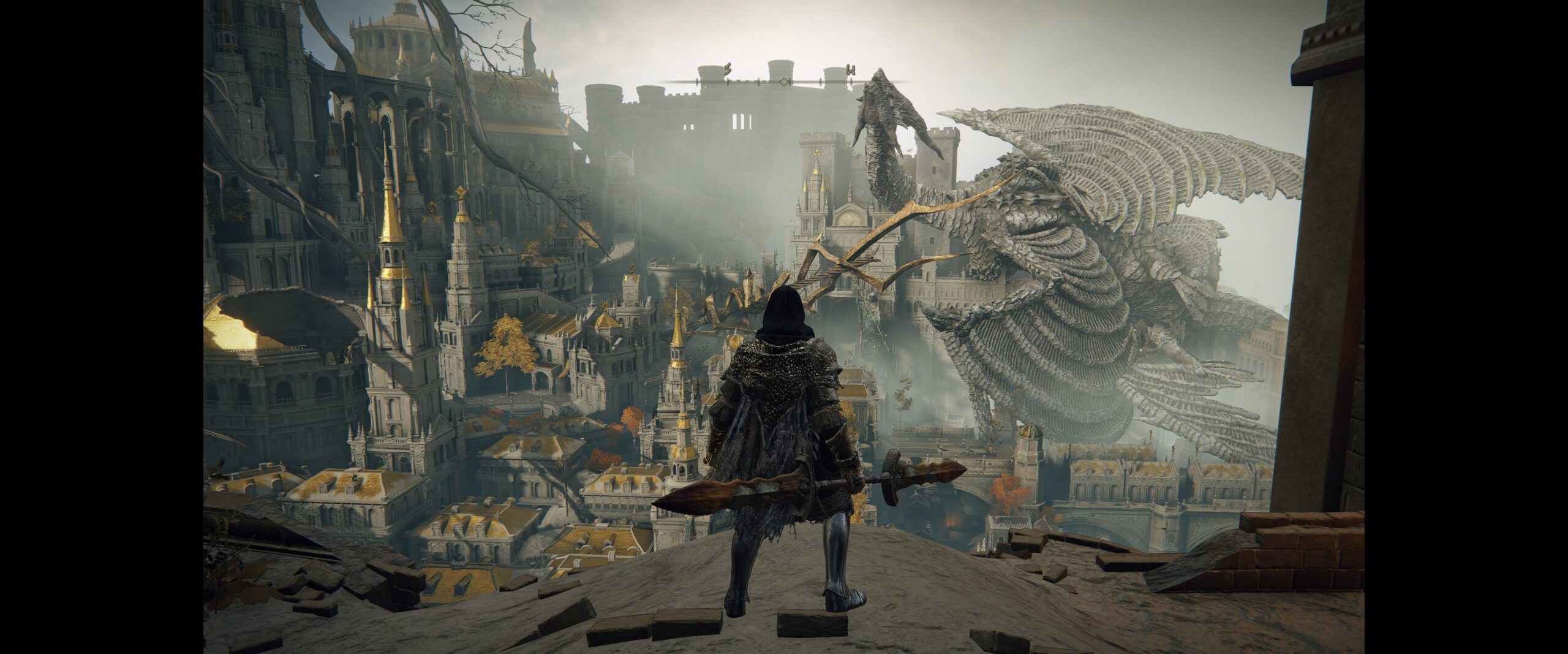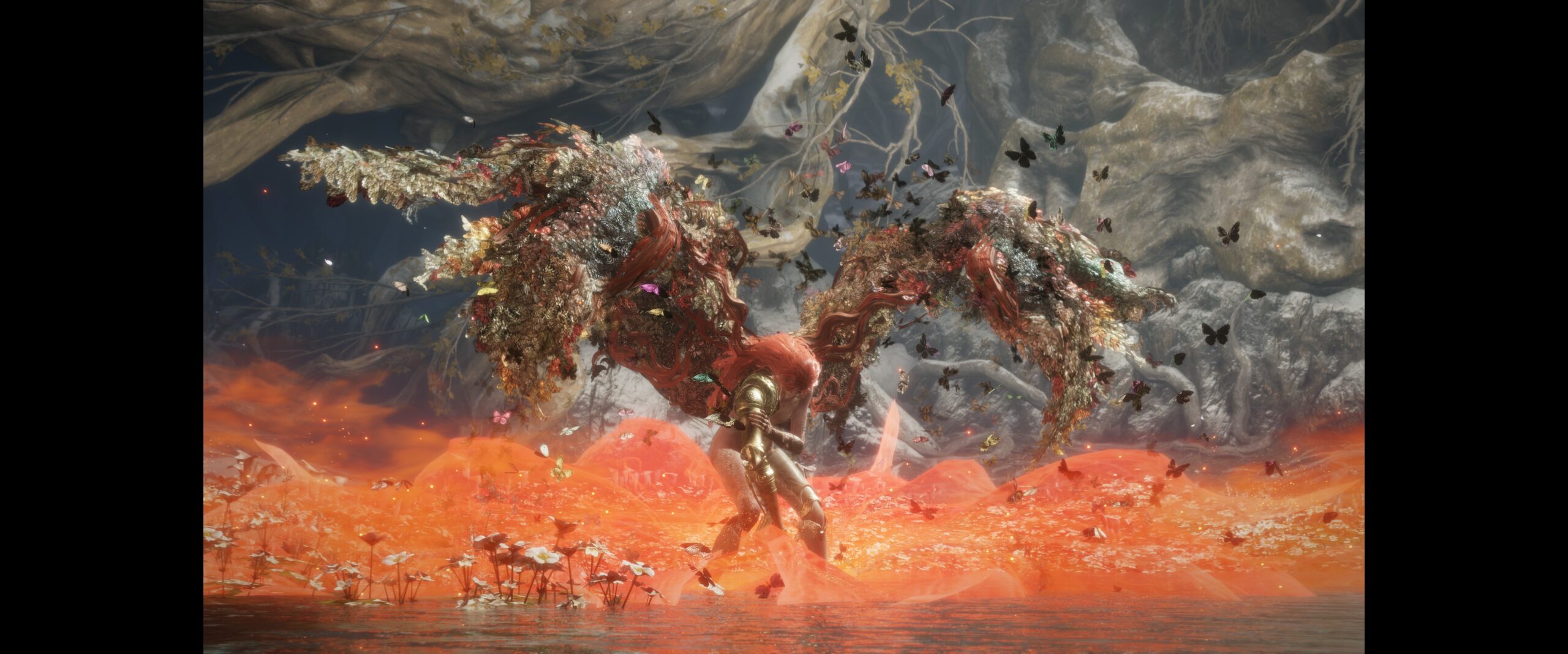I fucking did it; I got gud.
You see, there’s always this trepidation when it comes to a new soulsborne game: is this the one, the game, which finally breaks me. Is this the mountain upon which my lifeless corpse will be thrown upon countless times, only for it still to stand there no matter how hard I try? Because there’s always that possibility, whether it be due to getting older and not having the dexterity I once had or simply that I lacked the patience required to actually beat the challenge the game puts forward to me. I have to say that, in the early moments of Elden Ring I was pretty sure it was going to be the latter, my anxiety about playing grand scope like this making me far less patient than I used to be. However, like all of the FromSoftware games I’ve played, it eventually got its hooks into me and the challenges it put forward eventually revealing the true boss of these games once again: your own ego.

The Lands Between was once ruled over by the immortal Queen Marika, keeper of the Elden Ring that bestowed power upon her. One day the ring was shattered, breaking the land’s connection to the greater will and scattering fragments of power. Marika’s demigod children have since then began an unending war between each other for fragments of the ring which brings with it both power and terrible corruption. You are one of the Tarnished, a race of former inhabitants of the Lands Between whom were banished in order to strengthen their souls for one day, it is told, that a Tarnished will rise up and take Marika’s place as Elden Lord. Is it you then, lowly Tarnished, who seeks the throne? What hope does a maidenless one like yourself have to achieve such a goal.
FromSoftware’s games always feel like they’re a little bit behind the curve when it comes to graphic, but they certainly make up for it in spades with the spectacles they create with it. This is the first FromSoftware game that’s open world and boy howdy, is it ever. You’ll be finding yourself traversing all manner of biomes, each with their own unique aesthetic which is typically presented to you in a sprawling vista. The same aesthetic that they’ve used for numerous titles remains here; that tried and true Japanese RPG styling that we’ve all come to know and love. The slightly lower-end graphics is likely part necessity too, given that this game is also released on the PlayStation 4, a now almost decade old console. As you’d expect then performance is great, even when you really push things to their limit with spells and effects. Suffice to say, whilst I always have a slight aversion to FromSoftware’s graphics early on it quickly grows on me.

Whilst a true open world is new territory for FromSoftware the core gameplay loop of Elden Ring doesn’t really differ too much from its predecessors. You’ll start off as a lowly wretch, barely able to wield the starting kit provided to you whilst you battle against enemies several times your size and die unceremoniously numerous times. Similar to most open world games there’s a kind of, sort of, main quest line that you can follow with a smorgasbord of side quests for you to pursue when you have the inclination to do so. You’ll progress much the same way: defeating enemies to get runes which you then spend to upgrade your character. Weapons, armour, trinkets and other items are scattered around the world and are yours for the taking, many of them available to you upon immediately starting the game proper. You also have access to a horse this time around, which gives you both a rapid travel system and another style of combat. There’s also a bevy of other mechanics (spirit ashes, crafting, etc.) which blend old mechanics with new thinking, opening up enormous amounts of customisation to your playthrough. Truly though I can’t do justice to the breadth of scope of Elden Ring in one paragraph, it is simply too huge to summarise adequately.
A lot of people have asked myself and others the question: is Elden Ring the first soulsborne game I should try. The answer is, as it always is with any FromSoftware game, yes with an asterisk the size of Jupiter next to it. To be sure I believe Elden Ring offers a lot more avenues which provide more approachable ways to get into the genre but the core if it is still the same thing that brought people to it in the first place. This means that if you’ve looked at these games in the past, maybe even given them a go for an hour or two, and not been intrigued to play them further then Elden Ring won’t be the one to do it. The hype around the game is real and deserved in my opinion, but unless the idea of pitting yourself against an grueling challenge, even with the Fextralife wiki at the ready, then don’t even bother.

Combat maintains the same tropes that the FromSoftware franchise is famous for: telegraphed movesets that are incredibly punished if not read correctly. That is really oversimplifying it though as the build diversity available to you is greater than any other soulslike game I’ve ever played. This can easily be seen as a weak point for newer players though, as the path to min-maxing your build could not be less clear and many of the game’s tropes around weapons don’t necessarily align to what you think they might (greatswords scaling with dexterity and not strength? Really?). For this playthrough I thought it’d be interesting to play a hybrid role, as I’ve typically stayed much closer to the melee archetype for my other soulsborne experiences. So I chose the Confessor as my starting class, which in its base incarnation is actually quite viable for a good long while. However it does start to run out of options fairly quickly, and so I went in search of others.
I then ended up standardising on this build from Fextralife, essentially a twin blade fire/bleed build that utilises probably one of the most overpowered spells in the game: Flame of the Redmanes. This changed the game completely for me, taking me from a standard Dark Souls style combat style to one much more like Bloodborne, the first soulsborne game I ever cut my teeth on. Honestly I loved it, although it was clear where this build had limitations when it came to later game bosses who regenerated poise much faster than I could burn it down with successive casts of flames. I was on the verge of swapping the build out for the last 10 hours or so of the game but, honestly, a few talisman tweaks here and there, a few more levels and the right flask amped it up enough for it to be highly effective right through to the end.

I was initially pretty skeptical about Elden Ring’s open world setting, thinking it was just yet another thing FromSoftware would use to confuse and bewilder us. However after a while I started to appreciate it for the freedom it offered, giving you a directed (but definitely not optimal) path to your intended goal whilst also not stopping you from exploring areas freely if you should choose. Of course the open world it presents isn’t exactly a free roaming extravaganza as each of the areas has a hard set level of difficulty to them which, if you intend to challenge, will likely end up failing miserably or just waste exceptional amounts of time on. That being said it’s usually pretty obvious when you’re trying to punch above your weight, usually pushing you back to where you were previously. If you, like me, aren’t exactly wanting to spend countless hours wandering around then this guide fom (once again) Fextralife is a great way to right your course. I wouldn’t advise following it to the letter though as the amount of stuff that guide makes you do which isn’t completely necessary is burdensome. That being said though, as with all soulsborne games, consulting things like this on specifics of quests is a lifesaver.
One of the key things I always forget about soulsborne games is that, whilst there are objectively better/worse builds/items/questlines/etc., what you’re really wanting to expand is the number of options you have available to you. This is why the first half dozen hours or so with a game like this feels so gruelling: you simply do not have a full kit of different weapons, armour or trinkets to pull from which can take fights that are seemingly impossible to challenging, but winnable. This is made abundantly clear with things like spirit ashes, something I really did not understand at all until I went to fight Margit, the Fell Omen and wondered how the heck anyone could beat him at the stage of the game I faced him in (note: I was following graces directly, so was at him in only a handful of hours). Once you understand the kit bag you have, the challenge you’re facing and what you can do to maximise your chances of winning the game becomes much more enjoyable.

It wouldn’t be an Elden Ring review if I didn’t comment on and not-so-humbly brag that I beat the game’s hardest boss: Melania. To be sure it’s an incredibly challenging fight, one that I attempted for a good couple hours initially before leaving it and coming back with a number more levels and items under my belt. To be sure though, what mostly changed over the time I spent on this boss was, as it always is, my perception of what I needed to do to win. She’s an aggressive boss, one that punishes many of the behaviours that you would’ve have ingrained in yourself over the course of your long playthrough to get to her. For me though the secret sauce to beating her was unlearning the conservative playstyle I’d adapted for many of the other bosses; going absolutely ham on her with my twinblade build, which could readily interrupt most of her moves, made it a winnable fight. To be sure I was also using Black Knife Tiche, but whilst many will joke that she can summon any boss in Elden Ring that’s far from correct, especially given it doesn’t seem to understand what to do when Melania uses her waterfowl dance.
I ebbed and flowed with how I felt about Elden Ring over the course of my playthrough many times. The first couple hours were a bit of a slog, the game’s blend of mechanics still new to me and not at all intuitive. However once I had a few bosses under my belt I started to feel like I had a semi-decent grasp on everything. Then as I approached what I now know to be about the halfway mark I was feeling somewhat done with the game. That’s when I started to min/max my build as much as possible, and didn’t do many of the side quests in favour of ploughing through to the end. Strangely though, after a good 5 or so hours of doing this, I found myself enjoying the challenges again and started making my way through many of the optional bosses the game has to offer. I’ll admit part of this newfound fun was likely due to me being quite overpowered for the bosses I was now facing, my ability to stagger them almost endlessly whilst also ripping shreds off their health bar giving me no end of joy. I was, of course, brought back to reality numerous times by the game’s continuous difficulty spikes, but by then I was always ready for a new challenge.

For a game of this size Elden Ring is incredibly polished, although the standard fanfare of FromSoftware bugs, glitches and general weirdness still remain. You can often find yourself (or a key enemy) stuck on terrain that you have no hope of getting out of, something that’s made all the more frequent by the inclusion of a jumping horse. Hit boxes, whilst generally done well, can sometimes be wildly out of place with the enemy/hazard/thing that you’re interacting with, leading to some frustrating deaths that don’t feel earned. Input reading or position based attacks, whatever you want to call them, is still a thing leading to some enemies being far more frustrating than they feel they have the right to be. To be sure, once you understand how it works you can use it to your advantage sometimes, but often it feels like you’re getting punished based on your queued actions. For long time players of the genre though these are things we’re somewhat used to, even if they do mar an otherwise great experience.
You’d think that bringing on George R. R. Martin (who’s involvement may have been a touch overhyped) would’ve steered the game’s narrative towards a more approachable, cohesive and understandable story but it really didn’t. Whilst you can definitely piece together a few core narrative arcs if you’re so inclined even the lore wikis come up short on quite a lot of pertinent details, leaving you in much the same place as you where when you started. It’s one of the things that’s always made it hard for me to truly connect with the story or the characters of FromSoftware’s games as it always feels like the characters aren’t given enough time directly in core of the game to really shine. The best example I can think of is Godfrey, First Elden Lord, a character that has an awesome backstory that’s utterly unexplored in any of the parts of the game I managed to go through in my 50+ hours in it. Given how key he is to the overall narrative, and also being a non-optional boss, you’d figure there’d be more build up to him but there isn’t. It’s a shame really as whilst I do enjoy a good trawl through a wiki I wish the game gave me more to work with whilst I was actually playing it.

Chalk up yet another win for FromSoftware with Elden Ring, a game that I believe accomplishes all they set out to do and so much more. The changes to the formula have definitely improve the genre overall, providing fresh thinking and challenge to an otherwise mastered format. The usual caveats around the genre still very much apply though, and fans will still love the game despite it making the same mistakes its predecessors have for more than a decade. I honestly did not expect to play it for as long as I did, nor to enjoy it as much either. One of the marks of a truly great game is one that makes you enjoy it even despite your reservations and Elden Ring managed to do that for me in spades.
Rating: 9.5/10
Elden Ring is available on PlayStation 4, PlayStation 5, Xbox One, Xbox Series X/S and PC right now for $89.95. Game was played on the PC with a total of 55.3 hours playtime and 69% (nice) of the achievements unlocked.



